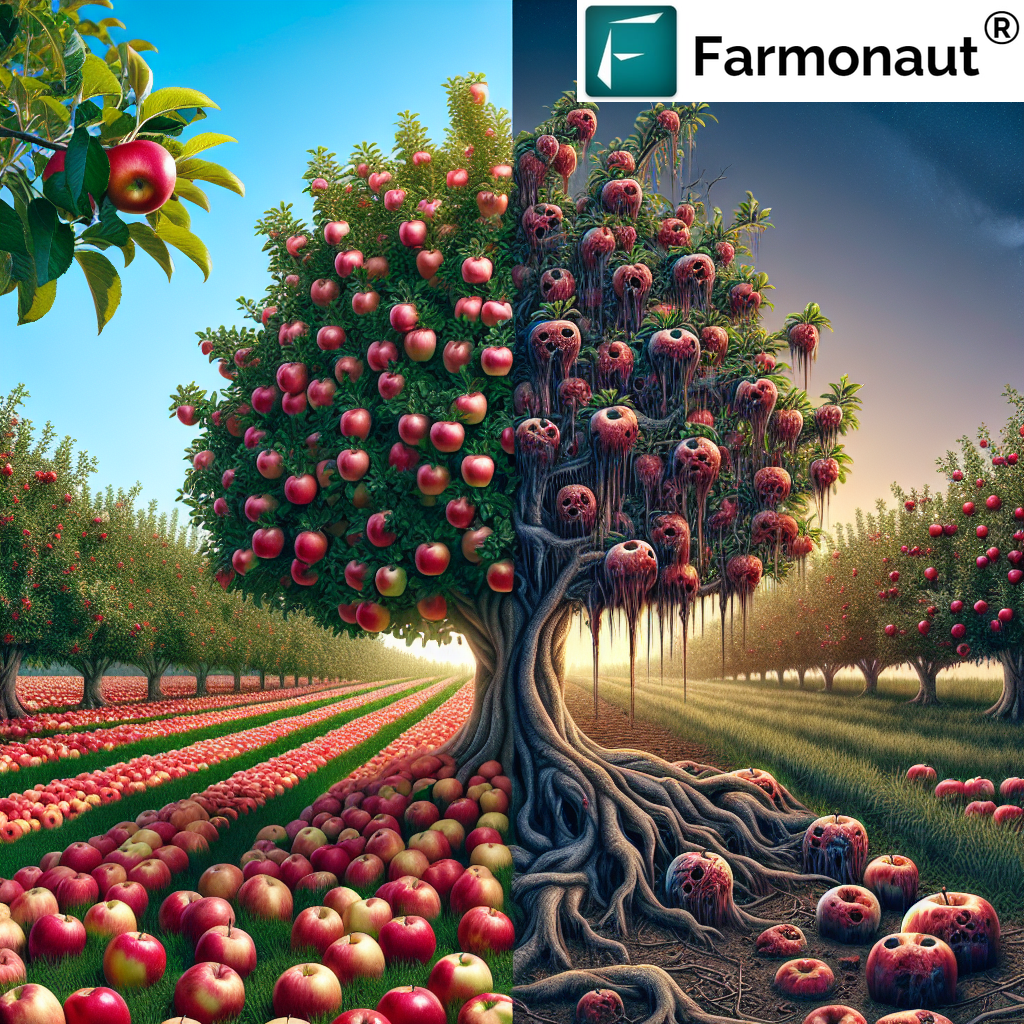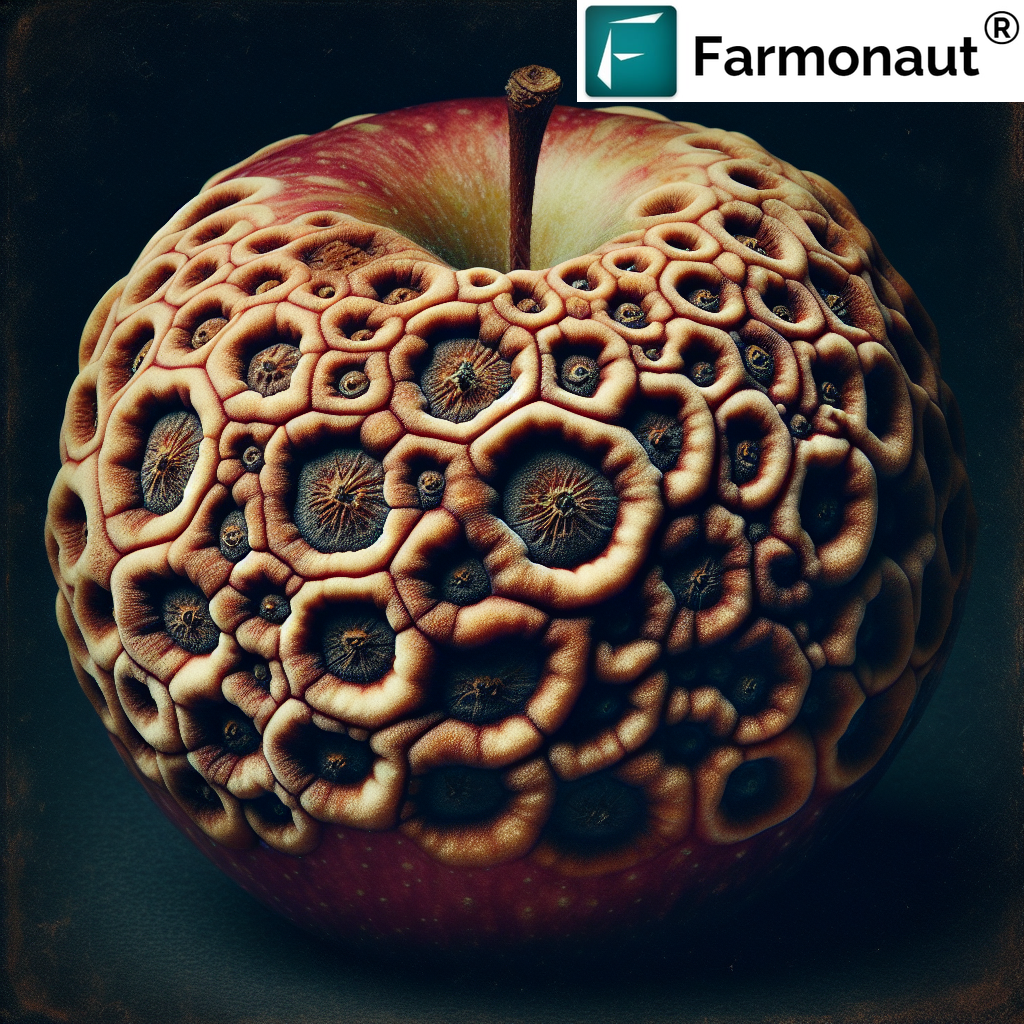Bitter Rot in Apples: A Comprehensive Guide to Identification, Prevention, and Management

At Farmonaut, we understand the challenges that apple growers face when it comes to managing orchard diseases. One of the most destructive and economically significant diseases affecting apple orchards worldwide is bitter rot. In this comprehensive guide, we’ll delve deep into the world of apple bitter rot, exploring its causes, symptoms, prevention strategies, and management techniques.
Understanding Bitter Rot in Apples
Bitter rot of apple, also known as bitter rot apple disease, is a fungal infection that can devastate apple orchards if left unchecked. This disease is caused by several species of fungi in the genus Colletotrichum, with the most common culprits being Colletotrichum gloeosporioides and Colletotrichum acutatum. These fungi thrive in warm, humid conditions, making them particularly problematic in regions with hot summers and frequent rainfall.
The Impact of Bitter Rot on Apple Production
The economic impact of bitter rot on apple production can be severe. In susceptible varieties and under favorable conditions for disease development, losses can exceed 50% of the crop. Beyond direct fruit loss, the disease can also lead to:
- Reduced marketability of infected fruit
- Increased production costs due to fungicide applications
- Long-term damage to tree health
- Potential loss of consumer confidence in affected orchards
Identifying Bitter Rot in Apple Orchards
Early detection is crucial in managing bitter rot apple disease. As agricultural technology experts, we at Farmonaut emphasize the importance of regular orchard monitoring. Here are the key symptoms to look out for:
Fruit Symptoms
- Initial Lesions: Small, circular, light brown to dark brown spots on the fruit surface
- Lesion Development: As the disease progresses, lesions expand and become sunken
- Concentric Rings: Characteristic dark and light brown concentric rings within lesions
- Spore Masses: Pink to orange spore masses appear in the center of lesions under humid conditions
- Internal Decay: V-shaped, brown, decayed area extending from the skin to the core

Leaf and Twig Symptoms
While bitter rot primarily affects fruit, it can also manifest on leaves and twigs:
- Leaf Spots: Small, purple-bordered circular spots on leaves
- Twig Cankers: Small, sunken areas on twigs that can serve as overwintering sites for the fungus
The Life Cycle of Bitter Rot Fungi
Understanding the life cycle of bitter rot apple fungi is essential for developing effective management strategies. The disease cycle typically follows these stages:
- Overwintering: The fungi survive winter in mummified fruit, twig cankers, and leaf debris
- Spring Activation: As temperatures rise in spring, the fungi produce spores
- Primary Infection: Spores are dispersed by rain and wind, infecting developing fruit
- Secondary Infection: New spores form on infected fruit, leading to further spread
- Continued Spread: The cycle continues throughout the growing season, with infections becoming more severe as fruit matures
Environmental Factors Influencing Bitter Rot Development
At Farmonaut, our advanced satellite-based monitoring systems help growers track environmental conditions that favor bitter rot development. Key factors include:
- Temperature: Optimal growth occurs between 20-30°C (68-86°F)
- Humidity: High relative humidity (>90%) promotes spore production and infection
- Rainfall: Frequent rain events facilitate spore dispersal and infection
- Wounding: Fruit injuries from hail, insects, or mechanical damage increase susceptibility
Prevention Strategies for Bitter Rot in Apple Orchards
Preventing apple bitter rot requires a multifaceted approach. Here are some key strategies we recommend:
1. Orchard Sanitation
- Remove and destroy fallen fruit and mummified apples
- Prune and remove dead or diseased wood
- Maintain a clean orchard floor by mowing or using mulch
2. Cultural Practices
- Improve air circulation through proper tree spacing and pruning
- Avoid overhead irrigation to reduce leaf wetness duration
- Maintain balanced tree nutrition to promote natural disease resistance
3. Varietal Selection
Choose apple varieties with known resistance to bitter rot. Some varieties with moderate to good resistance include:
- Enterprise
- GoldRush
- Liberty
- Pristine
4. Monitoring and Forecasting
Utilize advanced monitoring tools like Farmonaut’s satellite-based system to:
- Track weather conditions favorable for disease development
- Identify high-risk periods for infection
- Optimize timing of preventive measures
Management Techniques for Bitter Rot Control
When prevention isn’t enough, active management of bitter rot apple disease becomes necessary. Here are the key management techniques we recommend:
1. Chemical Control
Fungicide applications are often necessary for effective bitter rot control. Consider the following:
- Timing: Begin applications at petal fall and continue at 10-14 day intervals until harvest
- Products: Rotate between different fungicide classes to prevent resistance development
- Coverage: Ensure thorough coverage of fruit and foliage
- Captan
- Mancozeb
- Thiophanate-methyl
- Strobilurins (e.g., azoxystrobin, pyraclostrobin)
2. Biological Control
While still an emerging field, some biological control agents show promise in managing bitter rot:
- Bacillus subtilis-based products
- Trichoderma species
- Certain yeast species (e.g., Metschnikowia pulcherrima)
3. Post-Harvest Management
Proper post-harvest handling is crucial to prevent the spread of bitter rot:
- Quickly cool harvested fruit to slow fungal growth
- Sort and remove any infected fruit before storage
- Maintain proper storage conditions (temperature and humidity)
- Consider post-harvest fungicide treatments for long-term storage
The Role of Technology in Bitter Rot Management
At Farmonaut, we believe that technology plays a crucial role in modern orchard management, especially when dealing with diseases like apple bitter rot. Our satellite-based monitoring system offers several advantages over traditional methods:
| Feature | Farmonaut Satellite System | Drone-based Monitoring | IoT Sensors |
|---|---|---|---|
| Coverage Area | Large-scale (entire orchards) | Limited by flight time and regulations | Limited to sensor placement |
| Frequency of Data Collection | Daily to weekly updates | Dependent on manual flights | Continuous but localized |
| Cost-effectiveness | High (no on-site equipment needed) | Moderate (equipment and operator costs) | Variable (depends on sensor density) |
| Data Processing | Automated with AI integration | Often requires manual processing | Automated but limited in scope |
| Weather Independence | Can operate in most weather conditions | Limited by weather conditions | Generally weather-independent |
Our satellite-based system provides:
- Early detection of stress patterns that may indicate bitter rot infection
- Precise mapping of orchard zones requiring intervention
- Integration with weather data for improved disease forecasting
- Historical data analysis to identify recurring problem areas
Case Studies: Successful Management of Bitter Rot
While we don’t have specific case studies to share, our experience working with apple growers worldwide has shown that successful management of bitter rot apple disease often involves:
- Integrated pest management (IPM) approaches
- Timely implementation of cultural and chemical control measures
- Leveraging technology for improved monitoring and decision-making
- Continuous education and adaptation of management strategies
The Future of Bitter Rot Management
As we look to the future, several promising developments may enhance our ability to manage bitter rot in apple orchards:
- Genetic Resistance: Ongoing research into breeding apple varieties with enhanced resistance to bitter rot
- Precision Agriculture: Advanced sensing technologies and AI-driven decision support systems for more targeted interventions
- Novel Fungicides: Development of new, more environmentally friendly fungicides with improved efficacy against bitter rot
- Climate Adaptation: Strategies to manage bitter rot under changing climate conditions
Conclusion
Bitter rot remains a significant challenge for apple growers worldwide. However, with a combination of vigilant monitoring, integrated management strategies, and innovative technologies, it is possible to effectively control this disease and minimize its impact on apple production.
At Farmonaut, we are committed to supporting growers in their fight against apple bitter rot and other orchard diseases. Our advanced satellite-based monitoring system, coupled with AI-driven insights, provides growers with the tools they need to make informed decisions and implement timely interventions.
To learn more about how Farmonaut can help you manage bitter rot and other orchard challenges, download our app:
Android App
iOS App
For developers interested in integrating our satellite and weather data into their own systems, check out our API documentation.
FAQs about Bitter Rot in Apples
- Q: How quickly can bitter rot spread in an apple orchard?
A: Under favorable conditions (warm and humid), bitter rot can spread rapidly, potentially affecting a significant portion of the crop within weeks if left unchecked. - Q: Can bitter rot-infected apples be consumed?
A: While not typically harmful to humans, bitter rot significantly affects the taste and quality of apples, making them unsuitable for consumption or sale. - Q: Are organic methods effective against bitter rot?
A: Organic methods can be effective but often require a more intensive management approach, combining cultural practices, biological controls, and approved organic fungicides. - Q: How does climate change impact bitter rot incidence?
A: Climate change may lead to increased bitter rot pressure in some regions due to warmer temperatures and more frequent rain events, which favor disease development. - Q: Can satellite monitoring detect bitter rot before visible symptoms appear?
A: While satellite monitoring can’t directly detect bitter rot, it can identify stress patterns and conditions favorable for disease development, allowing for early intervention.
Ready to take your orchard management to the next level? Subscribe to Farmonaut’s advanced monitoring services: